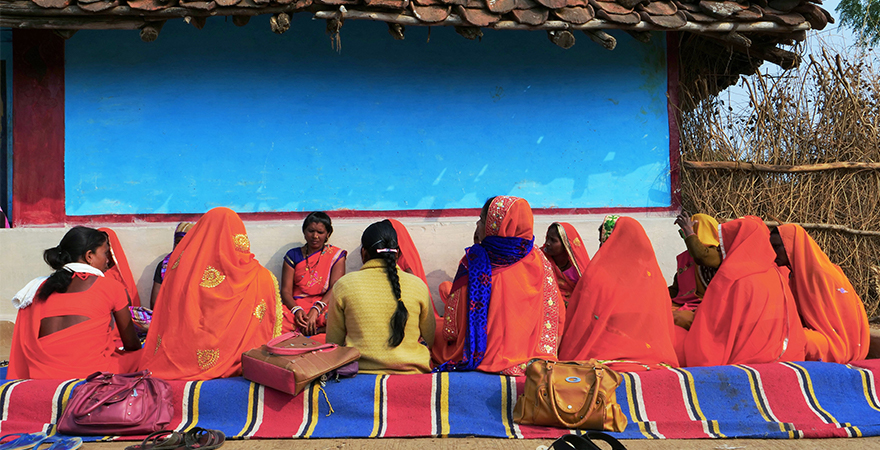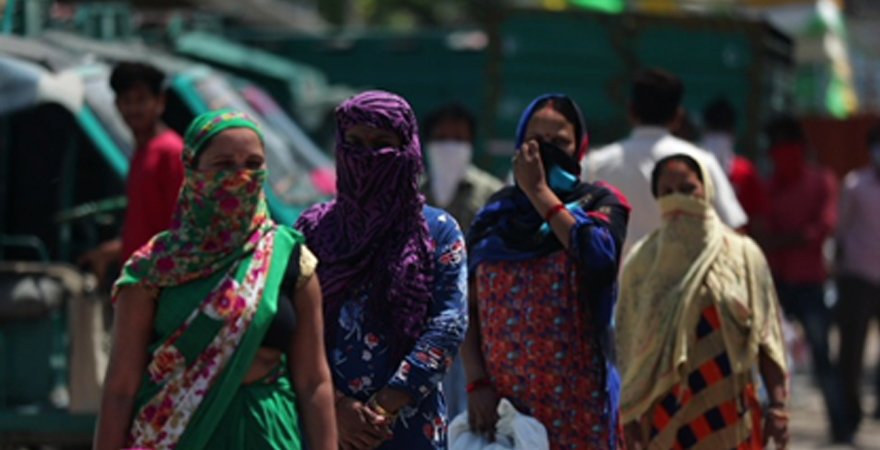Can Covid-19 provide opportunities to strengthen the SHG movement?

The Self-Help Groups (SHG) movement was introduced in India in the 1980s[1] to alleviate poverty, establish a platform for collective action, ensure access to rights and entitlements, as well as improve the health and wellbeing of women. Initiated by Non-Governmental Organisations[2] (NGOs) the movement was adopted and scaled by the Government of India through the Deendayal Antayodaya Yojana – National Rural Livelihoods Mission (DAY –NRLM) which has so far mobilised approximately 60 million poor women into SHGs across India.
SHGs are voluntary groups of up to 20 women, that come together on a weekly basis to pool savings and discuss issues of mutual importance. The pooled fund, deposited in the SHG’s bank account is used to support women in the form of loans. SHGs are founded on weekly meetings and savings and their success or failure is partially based on the frequency of these activities. The SHG, however, serves a function that goes well beyond finance; it is a source of collective action, mutual support and comradery. It provides a platform to impart knowledge and wisdom in the form of group discussions and informal conversations that women regularly engage in, thereby strengthening bonding and social capital. SHGs also draw on formal trainings imparted to them by the state and Civil Society Organisations (CSOs), to create awareness on various issues such as gender equality, livelihoods, health, gender based violence and so on.
Initiative for What Works to Advance Women and Girls in the Economy (IWWAGE) has been engaged with DAY-NRLM through its project SWAYAM [3] which supports gender trainings (undertaken by CSOs) and pilots to test the relevance and effectiveness of institutional platforms such as Gender Resource Centres (GRCs)/Gender Justice Centres (GJCs) in four states: Chhattisgarh, Jharkhand, Madhya Pradesh and Odisha. The concept of the GRC draws from the experience of similar platforms in Delhi and Kerala [4] where GRCs have been used to help women access schemes and programmes, as well as record their grievances. SWAYAM builds on a critical element of NRLM’s success i.e. the mission’s commitment towards prioritising women’s perspectives and being responsive to their needs and aspirations. This approach has been embedded across all DAY-NRLM activities and reflects in its primary goal of strengthening women’s agency, identity, well-being, and solidarity through women’s collectivisation.
 This approach and the ability of women to meet to discuss their needs and put forth their requirements, is likely to be put to test on account of COVID-19. SHG meetings have traditionally formed a space for women to gather mutual support and raise their grievances. They serve as an important platform for women to share their lives and aggregate for a common cause. They have been the fulcrum around which well-known movements such as the anti-arak (alcohol) movement in Andhra Pradesh have gathered force; and around which the Scheduled Caste women in states like Punjab are mobilising to collectively farm common lands. Such mobilisation will suffer if women are not permitted to meet.
This approach and the ability of women to meet to discuss their needs and put forth their requirements, is likely to be put to test on account of COVID-19. SHG meetings have traditionally formed a space for women to gather mutual support and raise their grievances. They serve as an important platform for women to share their lives and aggregate for a common cause. They have been the fulcrum around which well-known movements such as the anti-arak (alcohol) movement in Andhra Pradesh have gathered force; and around which the Scheduled Caste women in states like Punjab are mobilising to collectively farm common lands. Such mobilisation will suffer if women are not permitted to meet.
The lockdown announced in March 2020, to curb the spread of the Coronavirus in India has sent shockwaves across the Indian economy. Rural economies are in distress, with supply chains cut off, labour shortages and rising unemployment [5]. The lockdown has had immediate and devastating effects on women and girls [6]. Gender based violence is reportedly on the rise. Women’s unpaid labour has increased along with the anxiety to feed their families. Cash flow is limited and with prevailing social distancing norms, collectivisation has come to a total halt. All regular meetings and activities at the SHG, VO and CLF have stopped, for an indeterminate period of time [7]. Women not being able to move out of their homes (except for farm work), have lost spaces outside the home, such as SHG meetings, where they could come together and share intimate details of their private lives, including domestic abuse. With this space being closed, women have lost the space to share their experiences and have a community of support. This has and will continue to have large scale impact on the SHG movement.
IWWAGE has been in discussion with CSO partners [8], field level functionaries and SHG leaders in its four implementation states on the impact of the pandemic and the ensuing lockdown on SHGs, their daily functioning and their economic and non-economic activities. How will women’s SHGs transform during and post the crisis? And what impact will the crisis have on women’s solidarity and collectivisation?
Presently, no SHG activities are taking place. There are no meetings, no savings, no loan disbursement [9] or recovery. In June, rural India will enter a new sowing cycle. Women will most likely, at this time, prioritise their livelihoods which will affect attendance and frequency of SHG activities. They will have no time to meet, to discuss their needs or grievances. This is an important aspect that is likely to get diluted, but can be avoided, perhaps through innovative forms of online communication, and more hand-holding and outreach to women through gender champions including senior SHG leaders, community resource persons, Samta Sakhis and the like. For certain activities, SHGs have started using digital modes of communication such as WhatsApp. Use of digital tools while changing the nature of SHG meetings will allow the flow of correct information. However, online communication cannot be a substitute for the weekly SHG meetings, which should continue, with social distancing norms in place, as they are not only a platform for savings but also for ensuring collective well-being, food security and support.

SHGs have emerged as frontline workers and the last mile connect between governments and the people during this crisis. SHG women are playing a pivotal role in responding to COVID-19; they are making masks, hand sanitizers, PPE kits, distributing take home ration, disseminating COVID-19 related information and running community kitchens to feed the vulnerable[10]. The role of SHGs has never been more important than now and can prove to be a rare silver lining in the distress that SHGs are dealing with. Women can come forward and take leadership and development roles in their villages. It is an opportunity that the SHG movement must capitalize on.
Going forward, it will be important to strengthen the movement, to make sure it can absorb the economic, social and health shocks of the crisis. Post the lockdown governments should evaluate, the investment by SHG movement into COVID-19 response and its impact on the SHG economy. It would also be beneficial to have clear guidelines from the authorities, about when and how SHGs can reconvene and what precautions they must take while doing so. SHGs should also leverage digital platforms, to ensure the flow of correct information, to keep in contact with each other and with the modification of training pedagogies, to deliver certain types of trainings. While the digital platforms cannot be a substitute for weekly meetings, it goes some way in offering a temporary solution to the immediate problem. In these times when communication through technology marks a new form of solidarity, we must leverage the existing means at our disposal and find new and creative ways to progress; so that we do not lose the momentum gained in the SHG movement over the last 30 years.
Kaliat Ammu Sanyal is a Research Manager with IWWAGE, working with SWAYAM the NRLM vertical at IWWAGE. This piece draws from SWAYAM’s current work with Women’s Empowerment Collectives on gender mainstreaming across four states in India.
[1] “Self Help Groups (SHGs) in India.” 2014. New Delhi: Ethiopian Delegation
[2] Ramesh, Jairam. “Self-Help Groups Revolution: What Next?” Economic and Political Weekly 42, no. 36 (2007): 3621-624. Accessed May 13, 2020. www.jstor.org/stable/40276360
[3] Strengthening Women’s institutions for Agency and Empowerment (SWAYAM)
[4] “Kudumbashree | Gender Resource Center / Block Level Counselling Center”. 2020. Kudumbashree.Org. http://www.kudumbashree.org/pages/348. AND “Department Of Women & Child Development”. 2020 Revenue.Delhi.Gov.In http://revenue.delhi.gov.in/wps/wcm/connect/doit_wcd/wcd/Home/Gender+Resource+Centre+Project
[5] Mukherjee, Sanjeeb. 2020. “Rural Sector Stressed As Covid-19 Disrupts Supplies, Spikes Unemployment”. Business-Standard.Com. https://www.business-standard.com/article/economy-policy/rural-sector-stressed-as-covid-19-disrupts-supplies-spikes-unemployment-120032500780_1.html
[6] Deshpande, Ashwini. “Protecting Women Is Missing from Pandemic Management Measures in India.” Quartz India. Quartz, March 28, 2020. https://qz.com/india/1826683/indias-approach-to-fighting-coronavirus-lacks-a-gender-lens/
[7] SHGs are federated at the village level into Village Organisations (VOs) and consequently federated into a apex institution, a Cluster Level Federation (CLF). The VO and CLF meet regularly. The executive committee (EC) of the VO and CLF meet twice a month. EC1 meetings are to discuss social issues, convergence, rights and entitlements, while EC2 meetings are devoted to financial transactions
[8] ANANDI in Madhya Pradesh, PRADAN in Jharkhand, Chaitanya in Chhattisgarh and Project Concern International (PCI) in Odisha
[9] The only loan disbursement currently active is the distribution of the Vulnerability Reduction Fund (VRF)
[10] Kejriwal, Nita. “Covid-19: In Times of Crisis, Women Self-Help Groups Lead the Way.” Hindustan Times, May 3, 2020. https://www.hindustantimes.com/analysis/covid-19-in-times-of-crisis-women-self-help-groups-lead-the-way/story-SyXJVNPLUdVbSljkeaeszN.html
- Posted In:
- Latest Blogs

















































Leave a Reply